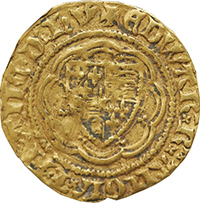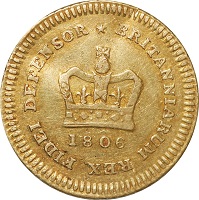British coin specifications

British coins have a rich history. Since the Norman Conquest in 1066, England and its neighbours used the likes of Pounds, Shillings and Pennies as the predominant currency up until decimalisation in 1970/1971. Many British coins have been produced over the past millennium, both in gold and silver, and knowing what each coin is worth can be difficult. Below you will find the various denominations and the coin value (face value) of each one, alongside their weights compared to other coins.
If you have a query about our collectable coins, or any of the specifications involved, then please contact our friendly customer services team on 0121 634 8060 or email us at support@bullionbypost.co.uk.
.
Farthing
|
Halfpenny
|
Penny
|
Three Halfpence
|
Half Groat
|
Thruppence
|
Groat
|
Sixpence
|
Shilling
|
Florin
Quarter Noble
|
Half Crown
|
Quarter Guinea
|
Half Noble
|
Double Florin
|
Crown
|
Trade Dollar
|
Noble
|
Angel
|
Third Guinea
Half Unite
|
Half Sovereign
|
Half Guinea
|
Unite (Pound)
|
Sovereign (Pound)
|
Guinea
|
Two Guinea
.
Numismatic & Collectible Coins
.

Years: 1279 - 1553 and 1613 - 1956 (demonetised in 1960).
Worth: Quarter of a Penny.
Weight: 2.83g - a little less than a modern 5p coin.
The name Farthing comes from the Anglo-Saxon word 'Feorthing', which means 'fourthling' or fourth part,
aka a quarter piece.
The earliest Farthings were made of silver and were first minted in the 13th Century, but later coins were
also in copper as permitted by King James I. The Royal Mint changed this in 1860, when the coins changed
to bronze.
.

Years: Early 1100s - 1701 and 17 17 - 1967 ( demonetised in 1969).
Worth: 2 Farthings.
Weight: 5.67g - a little lighter than a modern 10p piece.
Often pronounced as a Ha'penny (hay-pa-nee), the Halfpenny coin is worth two Farthings. Like the smaller
Farthing coin it was originally made from silver but, as the metal costs rose, so did the amount of coin
hoarding and coin clipping (shaving silver off).
The Halfpenny was changed to be made from a mixture of metals. Older coins were made of tin with a
centrepiece of copper, but tin's greater rate of wearing down has meant many of these coins aren't in a
great or even a full condition.
.

Years: 1707 - 1970.
Worth: 2 Halfpennies or 4 Farthings.
Weight: 1.45g approximately
Sometimes known as a 'Copper', the Penny coin was worth two Halfpennies or four Farthings. As with
many older coins it started out life as a silver coin and changed to copper and then bronze in later years
for cost purposes.
The symbol for Pence was d, not P. This was derived from the latin
'Denarius',
which was used to
describe standard silver coins in the Roman period.
Browse our selection of rare silver Penny coins.
.
Years: 1834 - 1843, 1860, 1862, 1870 (Proof Only).
Worth: 1 and a half pence.
Weight: 0.7g.
This small silver coin was a colonial issue, primarily for the West Indies and Ceylon, since renamed Sri Lanka.
The coin was approximately 12mm in diameter and worth 1.5 pence. The design bore a crown, wreath, and the
coin's value - 1 1/2 d - as well as the year of issue.
Two monarchs featured on these coins - King William IV and later Queen Victoria.
.

Years: 1351- 1856 (Special colonial edition 1888 - 1955).
Worth: 2 Pennies or 8 Farthings.
Weight: 1.15g approximately.
The Half Groat coin was first introduced during the reign of Edward III and continued to be produced by
the Royal Mint until the mid 1800s.
The Half Groat coin was produced after this cutoff date for British colonies, and is still to this day produced
specifically for the Maundy coinage - coins given out by the current monarch as the Maundy Thursday church
service the day before Good Friday. The coins are distributed symbolically now, but they were a royal act of
charity originally.
At BullionByPost we have a limited selection of Half Groats, available here.
.

Years: 1551 - 1970.
Worth: 3 Pennies / 12 Farthings / Quarter of a Shilling.
Weight: 1.4g - 1.5g (silver), 6.8g (copper/brass).
An old English word, a Thruppence or 'Thrupenny Bit' was a three pence coin. Sometimes nicknamed a 'Joey',
the coins had a value of 12 Farthings or a quarter of a Shilling.
The Threepence was 92.5% Silver until 1919, at which point it dropped down to 50% Silver post-war until after
the Second World War, and then was replaced with nickel-brass.
The first threepence coins were struck during the reign of King Edward VI, between 1547 and 1553, and were
produced either in London or York. The coin fell out of fashion during the reign of King James I but came back
into favour during the tenure of King Charles I, with the Aberystwyth Mint being the main producer of these coins,
just ahead of Bristol and Oxford.
This was the life cycle of the Thruppence; popular, unpopular, popular, unpopular. Different monarchs raised it
up or quashed it to suit their economic needs, but the coins are still used as Maundy money to this day.
.

Years: 1279, 1351- 1856 (Special colonial edition 1888 - 1955).
Worth: 2 Half Groats / 4 pence / 16 Farthings.
Weight: 3.75g approximately.
It takes no major thinking power to deduce that a Groat is worth two Half Groats. This four pence coin was very commonly used, and as such there were variations in England, Scotland and Ireland.
Groats were never quite as pure as the official specifications stated them to be; partly because of the difficulty in ensuring consistency centuries ago, but also due to the rate of production leaving little time to be picky.
To see our selection of Groats, click here.
.

Years: 1551 - 1970.
Worth: 24 Farthings / 12 Halfpennies / 6 pennies / Half a Shilling.
Weight: 2.83g approximately.
The Sixpence was a run-of-the-mill coin. The
Thrupenny Bit
is a quarter of a Shilling as you will have read above,
and the Sixpence is half a Shilling - also known as a 'Tanner'.
Like many coins from this period, it began life as a near-pure silver coin and slowly decreased in purity due to the
First and Second World Wars, before changing to cupro-nickel in 1947 and ceasing to exist after 1970, bar use as
Maundy money. The coins were recommissioned from 2016 to be made from 92.5% silver once more.
.

Years: 1502 - 1971.
Worth: 12 pence or 3 Groats.
Weight: 29.8g approximately.
The Shilling is one of the most recognisable names of a British coin. It was a major part of the circulated
currency. Popularly referred to as 'A Bob', the coin was worth 12 pence or 3 Groats.
Shillings were originally called Testoons, and first produced during the reign of King Henry VII (1485 - 1509).
The name later changed to Shilling in the 1600s, though the exact date is unknown.
On paper a Shilling was denoted as 'S', but this was not for Shilling - it was in fact for the latin 'Solidus',
which was a near solid gold coin. This is somewhat ironic given that Shillings are actually a silver coin.
View our range of collectable Shilling coins.
.

Years: 1344 - 1470.
Worth: 5 Groats or 1 Shilling & 2 Groats.
Weight: 1.89g approximately.
Nobles are one of the older coin varieties produced in England and the first to be mass produced.
Full sized Nobles came first, but soon after followed Half and Quarter Nobles.
A quarter Noble had a value of 20 pence, which is either 5 Groats or a Shilling and 2 Groats.
Click the link to see our rare Quarter Noble gold coins.
.

Years: 1849 - 1967 (Collector's Edition in 1970).
Worth: 6 Groats or 2 Shillings.
Weight: 11.31g.
Florins, also known as a Two Bob Bit, were worth two Shillings - two Bob. They were equal to 6 Groats
or 24 pence. These coins were limited in their production, with the Royal Mint only minting between 1849
and 1967 for circulation, and again producing a collector's edition in 1970 as a final hurrah.
There was some controversy surrounding the first released Florin. Like the Crown released at the time,
it featured Queen Victoria wearing a gothic crown on her head, but unlike the Crown coin it made no
mention of god. Thus was born the 'Godless Florin', also dubbed 'Godless and Graceless'.
Florins were introduced as a flexible option for the British public and businesses to use in dealing with
other nations that had already been through the process of decimalisation.
Take a look at our Florin page to see which coins we have in stock. .
.

Years: 1526 - 1551 (gold), 1551 - 1751, 1816 - 1970.
Worth: 2 Shillings & Sixpence.
Weight: 15g approximately.
30 pence in the 18th Century got you a Half Crown, which could also be worked out as 2 Shillings and
sixpence.
The weights of these coins vary but they are approximately 15g - a little heavier than a modern £2 coin.
Crowns and Half Crowns were first minted in 1549 and were produced for hundreds of years. At BullionByPost
we have Half Crown coins available featuring King James I, William of Orange and Mary II, and George II.
Browse our selection of Half Crown silver coins.
.

Years: 1344 - 1470.
Worth: 10 Groats or 3 Shillings & 1 Groat.
Weight: 3.41g roughly (coin consistency varies)
Two quarter Nobles make a half. The Half Noble was worth 40 pence, which could be achieved with
Pennies
but more likely it would be 10 Groats or 3 Shillings and a
Groat.
.

Years: 1887 - 1890.
Worth: 12 Groats or 4 Shillings.
Weight: 22g approximately.
Like the single
Florin,
the double variety was a limited edition production by the Royal Mint, though much rarer
due to the fact the Double Florin silver coins were only produced between 1887 and 1890 - a four year window.
Double Florins weigh roughly 22 grams and were made of 92.5% silver; a common purity for the Victorian Era.
They had the same value as 4 Shillings or a fifth of a Pound (a Sovereign).
Crowns were worth 5 Shillings. The Double Florin was worth 4 Shillings. The coins were made of the same purity
of silver, were almost identical in size, had the same portrait of Queen Victoria, the same shields on the reverse,
and neither coin stated their denomination. As such, the coin was dubbed 'Barmaid's Ruin' or 'Barmaid's Grief'
due to the difficulty in telling the difference and the inevitable fact they will be short changed for their services.
The Double Florin silver coin is an excellent piece to add to any coin collection.
.

Years: 1526 - 1551 (gold), 1551 - 1751, 1816 - 1970.
Worth: 5 Shillings / Quarter of a Pound.
Weight: 28g approximately.
A Crown was another of the big coins used in circulation in Britain. The Crown was worth 60 pence or 5 Shillings
and was occasionally referred to as a 'Dollar'.
Crown coins were originally gold when first produced during the reign of King Henry VIII back in 1544, but the
coins changed to silver in 1551 during the reign of Henry's son, Edward VI.
Due to their 38mm diameter, the coins were not popular, and their silver content led to many being smelted
down for metal rather than spent.
Click here to view our collection of rare Crown gold and silver coins.
.

Years: 1804 - 1811 (Dollar tokens), 1895 - 1935 (Trade Dollars).
Worth: 5 Shillings (later 5 Shillings & 3 pence).
Weight: Between 26.5 and 27g approximately.
The first edition of the Trade Dollar was a Dollar token coin, which was a re-stamped Spanish American 8
Reales coin. This coin is better known as a 'piece of 8' - as mentioned in the Pirates of the Caribbean films.
The production of this coin was a test performed by the Soho Mint in Birmingham, as the Royal Mint had
little confidence in the outcome. Inevitably, the re-stamping process was not that effective in substituting
the head of King George III over King Ferdinand of Spain, and around public jokes circulated along the
lines of "The Bank to make their Spanish Dollars pass, stamped the head of a fool on the neck of an ass”
and “Two kings’ heads are not worth a crown”.
The second edition came some time later and followed the Opium Wars in the Far East between Britain
and China. Britain won, and in doing so gained access to Chinese ports, having held colonies in the East
for a number of years. These coins were minted to be uniform - along with Trade Dollars in the US and
Spain amongst others - at .900 purity to satisfy the Chinese authorities. Between 1903 - 1935 these Trade
Dollars became for use in Hong Kong exclusively.
.

Years: Only minted in 1718 and 1762 respectively.
Worth: Five Shillings & Threepence.
Weight: 2.13g.
A very rare coin, the gold Quarter Guinea was only made twice, in two 1-year spells; 1718 and again in 1762.
The first coin was produced during the reign of King George I, and the second was during the rule of King
George III.
Browse our Quarter Guinea gold coins.
.

Years: 1344 - 1470.
Worth: 6 Shillings & 8 pence / 6 Shillings & 2 Groats / 1 Crown & 1 Quarter Noble.
Weight: 9g roughly (coin consistency varied).
The Noble gold coin was worth 80 pence, which is an alternate value of 6 Shillings and 2 Groats or 1 Crown
and
a quarter Noble.
Nobles were the first mass produced gold coin in England and were introduced
between 1344 and 1346 during the reign of King Edward III.
It was often written down that a Noble was worth 6/8, referring to the 6 Shillings and 8 pence - the worth of
2 Groats.
.

Years: 1465 - 1642.
Worth: 6 Shillings & 8 pence; later 11 Shillings.
Weight: 5g to 5.15g approximately.
The Angel coin was the forerunner to many British coins. It featured the Archangel Michael slaying a dragon -
imagery that would inspire Benedetto Pistrucci's design of St George slaying the dragon on British Gold
Sovereigns.
The coin grew in value during its production, but was later abandoned. Its successor is the gold Guinea, but
the private Pobjoy Mint produced a run of
Gold Angel coins
for the Isle of Man.
View our rare gold Angel collectable coins.
.

Years: 1797 - 1804, 1806, 1808 - 1811, 1813.
Worth: 7 Shillings.
Weight: 2.7g approximately.
The Third Guinea was, as its name suggests, a 1/3 of a Guinea in weight and overall worth. The coins were
only produced during the reign of King George III, and most were made after the unification of Great Britain
and Ireland, which was formalised at the turn of 1801.
.

Years: 1603 - 1663.
Worth: 10 Shillings.
Weight: 4.56g approximately.
The Half Unite was the half-size version of the Unite coin; the second Pound coin to circulate in England. The Unite coins were introduced by the Tower Mint in London under the rule of King James I, who wanted to commemorate
the unification work between England and Scotland but also to regulate British currency more.
The coin had a value of 10 Shillings, though in line with the value rise of the Unite coin this rose to 11 Shillings briefly.
At BullionByPost we have a selection of
Half Unite gold coins
available to buy.
.

Years: 1544 - 1604, 1817 - Present
Worth: 10 Shillings / 2 Crowns / Half of a Pound.
Weight: 3.99g.
The Half Sovereign is still in use today, but it is an old coin and did have an equivalence in the old coin system
pre-decimalisation. A Half Sovereign was effectively half a Pound, and as such had a value of
10 Shillings.
The Half 'Sov' weighs 3.99g and is made of 22 carat gold. The coins were first made in 1544 during the reign
of King Henry VIII, until 1604, and then recommissioned in 1817 with the major overhaul of British coinage.
Like the full Sovereign, the coin features the monarch on the obverse and typically St George and the Dragon
on the reverse, though some years instead featured a shield back design.
At BullionByPost we have a broad range of old and new gold Half Sovereigns in stock and available today.
.

Years: 1663 - 1814.
Worth: 10 Shillings & Sixpence / 2 Crowns & Sixpence.
Weight: 4.2g approximately.
Guineas and Sovereigns / Pounds were not too different in value, but the Guinea was worth fractionally more.
This is due to the gold quality, sourced through the British Empire and colonialism from the Guinea Coast near
what is now modern day Ghana and Togo.
A Half Guinea was worth 10 Shillings and sixpence.
Click here to see more Half Guinea coins.
.

Years: 1603 - 1663.
Worth: 20 to 22 Shillings.
Weight: 9.65g approximately.
The Unite gold coin was the second oldest Pound coin, following on from the old English Sovereign. It was later replaced by the Laurel, which was the third Pound coin in Britain.
Its value was 20 Shillings, as set by the Tower Mint who produced the coins, but it increased slightly due to the
rising price of gold in Europe. The price reset back to 20 Shillings in time for the Laurel's mintage.
Click to see our selection of gold Unite pound coins.
.

Years: 1544 - 1604, 1817 - Present
Worth: 20 Shillings or 4 Crowns
Weight: 7.98g.
The Sovereign was the former Pound coin. There were 4
Crowns
to the Sovereign, or 20 Shillings. It was typically
a split usage between Sovereigns and Guineas, with this coin being primarily used on a day to day basis.
The English Gold Sovereign was first minted in 1544 during the Tudor period, though production ended in 1603.
The Unite (see above) and then the Laurel were the next Pound coins, before British Sovereigns were introduced
in 1817 as part of the Great Recoinage.
Gold Sovereign coins weigh 7.98g, have a purity of 22 carats, and are around 22.05mm in diameter.
View gold Sovereign coins here.
.

Years: 1663 - 1814.
Worth: 21 Shillings or 1 Pound & 1 Shilling.
Weight: 8.4g approximately.
The Guinea gold coin was worth 21 Shillings or 1 Pound and 1 Shilling. As mentioned earlier, Guineas had a
slightly increased valuation due to the source of their gold. This made the Guinea an ideal coin for usage
between gentlemen and the upper classes - paying that little bit extra compared to the Sovereign showed
they were both wealthy and generous, and both were ways of earning social status in Britain.
Browse our gold Guinea collection.
.

Years: 1664 - 1753.
Worth: 42 Shillings or 2 Pounds & 2 Shillings.
Weight: 16.56g approximately.
The Two Guinea coin was a rarer production than other circulated coins but not as rare as the
Double Florin.
First minted in 1664, the coin was simply a larger bullion coin than the standard Guinea. Production ended in
1753 as other coins became more useful and popular.
The Two Guineas coin was around before the Sovereign, so initial Guinea values were 20 Shillings and 40 Shillings,
but with the introduction of the Sovereign this increased to 21 and 42 respectively.
The gold for these coins came from the Royal African Company and often sees the organisation represented with
elephants on these coins.
Interested? Take a peek at our Two Guinea coin category.
.
Don’t see your coin on here? Think we’ve missed a piece of history? Let us know!
At BullionByPost we’re always updating our website to be as informative as possible. Call us on 0121 634 8060 or email us at support@bullionbypost.co.uk and we’ll be more than happy to tweak our content.
.
Related Links
Britannia Coin Designs | Sovereign Coin Designs | Sovereign Mint Marks | Numismatic Gold Coins | Numismatic Silver Coins
.
- How To Buy Gold
- How to Buy?
- Payment Options
- Delivery Options
- Gold Storage
- Storage at Brink's
- Gold Investment Guide
- Why buy gold?
- Is gold a good investment?
- Why physical gold?
- Best time to buy gold?
- Gold bars vs coins?
- Gold vs Silver
- Gold - Silver Ratio explained
- VAT on bullion
- CGT on bullion
- Legal tender coins
- Top 5 Gold Investments
- Top 5 Silver Investments
- Gold vs ISAs
- Gold vs Buy-to-Let
- Gold vs FTSE 100
- Gold vs Bitcoin
- Where to buy gold?
- Why buy from us?
- Where to sell gold?
- Coin Shops
- Gold Price Forecasts
- Top 10 Gold Producers
- Top 10 Gold Reserves
- Gold Britannia vs Sovereign
- Britannia coin designs
- Sovereign coin designs
- Sovereign Mintages
- Sovereign mint marks
- British coin specs
- What is a proof coin?
- Royal Mint bullion
- The Queen's Beasts
- Royal Mint Lunar Coins
- Bullion Refiners
- British coin mints
- Krugerrands
- Gold Tola - India & Pakistan
- Bullion Index













